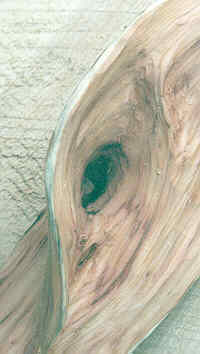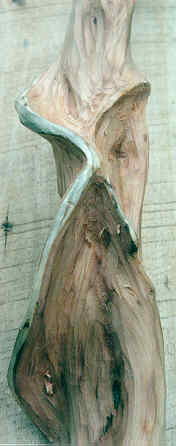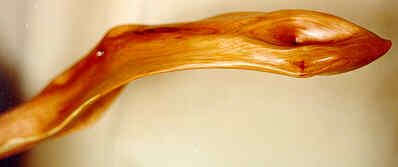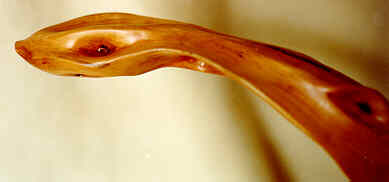Bill Judt, (see his web page) our editor and publisher, suggested that I write an article on how I create the ridges in diamond willow pieces that I work with. This suggestion came after he saw Moire' Eel in progress (see front cover).
What Bill didn't seem to understand is that the ridge in that piece was already there; my role was to make use of it in the composition. However, a little later, I began working on a pair of walking sticks. As I sized up the two pieces of raw wood, I saw that one had some beautiful ridges waiting to be exposed, while the other had flatter diamonds. The base of the second piece suggested a snake with a flared neck, such as a cobra or (as I found out while looking for reference materials on cobras) a hog-nosed snake. I would need to accentuate the flaring in order to create the desired stylized representation. Much later as I progressed on the carving, I created an "artificial diamond", something I had never done before. Here then is the story of the ridges on two walking sticks.
The two raw pieces of willow looked like this:
The excellent ridges can be seen on the lower third of the left hand stick (SS#1). The flared neck of a snake can be seen (with some imagination) on the upper end of the right hand stick (SS#2). This is a close-up of the base of the two sticks. SS#1 is now on the right. Its naturally occurring ridges are more obvious now compared to the flatter diamonds of SS#2. After removing the bark, SS#1 started to reveal its hidden beauty. I use a variety of knives and gouges to remove the bark and do the minor alterations in shape required to make the piece into a functional walking stick.
 |
 |
 |
 |
| Many of the diamonds were narrow and deep. It is a challenge to clean the bark out and then sand them. | At the start of the ridges, one diamond opened up like a calla lily. Its center went to within about 1/4" of the far side. | This is approximately the same view as seen in the previous table. Note the very thin line of sapwood where the tree was trying to grow until it finally got choked off. | Some time later, after the rough sanding has been done. The subtle color variations start to be more noticeable. This is a very sensual stage of the process. |
SS#2 was less remarkable in its character, but the fun came in creating a stylized sculpture at the top of the walking stick. After some research on snakes, I decided on a prairie hog-nosed snake. I have never seen one live, but apparently they are sometimes found as far north as southern Saskatchewan.
 |
 |
| This is the finished head from the same side as immediately above. Three coats of satin urethane finish has been applied after the piece was sanded to 320 grit. |
 |
| This is the other side of the head. Here the natural diamond created an almost perfect eye and cheek. The flared neck was thinned on this side also, although I tried not to interfere too much with flow of the diamonds. |
 |
 |
 |
| Here are the finished walking sticks in approximately the same positions as seen in the very first image. I put brass ferrules on the bottom to prevent cracking and to slow down wear. | This is a close-up of the tops. SS#1, on the left, is called "No Snake Here". There is actually the hint of a calf's head facing off to the left. SS#2, on the right, is called "Prairie Hog-Nosed Snake". | This is a closer view of the finished ridges on SS#1. It is an extraordinary piece of diamond willow. I consider myself honored to have had the opportunity to carve it. |
Incidentally there is a third walking stick in this series, SS#3 "Leonard! Where Are You?", which has a prairie rat snake and two northern leopard frogs on it. It had no pronounced ridges, but it was another amazing piece of wood to work with.